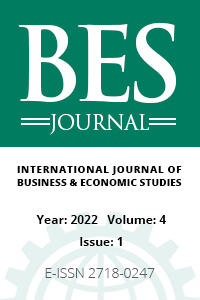Macroeconomic Factors Affecting the Volume of Consumer-Based Problem Loans in Turkey: Analysis through Econometric Methods with Structural Breaks
Non-performing loans, unit root tests with the structural break, maki
Macroeconomic Factors Affecting the Volume of Consumer-Based Problem Loans in Turkey: Analysis through Econometric Methods with Structural Breaks
___
- ALTUNÖZ, Utku (2018), “Sorunlu Krediler Bağlamında Türk Bankacılığında Kredi Kayıp Karşılığının Makroekonomik Değişkenlere Etkisi: Panel Data ve Zaman Serileri Analizi”, Hitit Üniversitesi Sosyal Bilimler Enstitüsü Dergisi, S.11(1), ss. 63-82.
- ASLAN, Özgür ve KÜÇÜKAKSOY, İsmail (2006), “Finansal Gelişme ve Ekonomik Büyüme Ilişkisi: Türkiye Ekonomisi Üzerine Ekonometrik Bir Uygulama”, Ekonometri ve İstatistik e-Dergisi, S. (4), 25-38.
- SILVESTRE, Josep L. C. İ., KIM, Dukpa ve PERRON, Pierre (2009), “Hem sıfır hem de alternatif hipotezler altında birden çok yapısal kırılmaya sahip GLS tabanlı birim kök testleri”, Ekonometrik teori, ss. 1754-1792.
- ÇİFTÇİ, Rukiye (2016), “Türk Bankacılık Sisteminde Sorunlu Krediler ve Makroekonomik Konjonktür” (Master's thesis, ESOGÜ, Sosyal Bilimler Enstitüsü).
- BAŞ, Gizem ve KARA, Mehmet (2020), “Türkiye’de Döviz Kuru ile Sorunlu Krediler İlişkisi: Bir Zaman Serisi Analizi”, Kafkas Üniversitesi İktisadi ve İdari Bilimler Fakültesi Dergisi, S. 11(22), ss. 997-1023.
- GÖKTAŞ, Özlem (2005), Teorik ve Uygulamalı Zaman Serileri Analizi, İstanbul: Beşir Kitabevi.
- HACKER, Scott, R. ve HATEMI, Abdulnasser, J. (2006), “Asimptotik ve Önyükleme Dağılımlarını Kullanarak Entegre Değişkenler Arasındaki Nedensellik Testleri: Teori ve Uygulama”, Uygulamalı Ekonomi, S. 38 (13), ss. 1489-1500.
- PHILLIPS, Peter, C.B. ve HANSEN, Bruce, E. (1990), “Eşbütünleşme Modellerinde Tahmin ve Çıkarım: Bir Simülasyon Çalışması”, Ekonometride Gelişmeler, S. 8 (1989), 225-248.
- KABATAŞ, Yaşar ve KARAMUSTAFA, Cemal (2019). “Tüketici Kredilerinde Takipteki Kredi Oranlarının Makroekonomik ve Bankalara Özgü Belirleyicileri: Türkiye Örneği”, Journal of Marmara Social Research/Marmara Sosyal Arastirmalar Dergisi.
- KOYUNCU, Cüneyt ve BERRİN, Saka (2011), “Takipteki Kredilerin Özel Sektöre Verilen Krediler ve Yatırımlar Üzerindeki Etkisi”, Dumlupınar Üniversitesi Sosyal Bilimler Dergisi, S. (31), ss. 113-124.
- KUZU, Serdar ve ÇELİK, İsmail Erkan (2019), “Türk Bankacılık Sektöründe Sorunlu Kredileri Belirleyen Değişkenlerin Analizi”, Social Sciences, S. 14(4), ss. 1637-1656.
- LEE, Junsoo ve STRAZICICH, Mark, C. (2004), “Bir yapısal kırılma ile minimum LM birimi kök testi”, El Yazması, Ekonomi Bölümü, Appalachian Eyalet Üniversitesi, S. 33 (4), ss. 2483-2492.
- LUMSDAINE, Robin L. ve PAPELL, David H. (1997), “Multiple Trend Breaks and the Unit-Root Hypothesis”, Review of Economics and Statistics, S. 79(2), ss. 212-218.
- MAKI, Daiki (2012), “Tests For Cointegration Allowing For An Unknown Number of Breaks”, Economic Modelling, S. 29(5), ss. 2011-2015.
- MAZREKU, Ibish, MORINA, Fisnik, MISIRI, Valdrin, SPITERI, Jonathan V. ve GRIMA, Simon (2018), “Determinants of the Level of Non-Performing Loans in Commercial Banks of Transition Countries”, European Research Studies Journal, S. 21(3), ss. 3-13.
- RADIVOJEVIĆ, Nikola, CVIJANOVIĆ, Drago, SEKULIC, Dejan, PAVLOVIC, Dejana, JOVIC, Srdjan and MAKSIMOVIĆ, Goran (2019), “Econometric Model of Non-Performing Loans Determinants”, Physica A: Statistical Mechanics and its Applications, S. 520, ss. 481-488.
- SELIMLER, Hüseyin (2015), “Sorunlu Kredilerin Analizi, Banka Finansal Tablo ve Oranlarına Etkisinin Değerlendirilmesi”, Finansal Araştırmalar ve Çalışmalar Dergisi, S.7(12), ss. 131-172.
- ŞAHBAZ, Nazan ve İNKAYA, Ahmet (2014), “Non-Performing Loans in Turkish Banking Sector and Macro Economic Effects”, Optimum Ekonomi ve Yönetim Bilimleri Dergisi, S. 1(1), ss. 69-82.
- TANDON, Deepak, CHATURVEDI, Arvind ve VIDYARTHI, Harishankar (2017), “Non-Performing Assets and Profitability of Indian Banks: An Econometric Study”, International Journal of Business Competition and Growth, S.6(1), ss. 60-76.
- TORUN, Melike ve ALTAY, Erdinç (2016), “Ticari Bankacılık Sektöründe Sorunlu Kredileri Etkileyen Faktörlerin Analizi”, Yönetim ve Ekonomi Araştırmaları Dergisi, S. 17(1), ss. 179-200.
- ULUCAK, Recep ve ULUCAK, Zübeyde Ş. (2014), “Kamu Harcamaları Ve Ekonomik Büyüme Arasındaki Nedensellik: Türkiye Örneği”, Uluslararası Yönetim İktisat ve İşletme Dergisi, S. 10(23), ss. 81-98.
- YÜCEMEMIŞ, TANINMIŞ, Başak ve SÖZER, İnanç (2011), “Bankalarda Takipteki Krediler: Türk Bankacılık Sektöründe Takipteki Kredilerin Tahminine Yönelik Bir Model Uygulaması”, Finansal Araştırmalar ve Çalışmalar Dergisi, S.3(5), ss. 43-56.
- YÜKSEL, Serhat (2016). “Katılım Bankalarında Karlılığı Belirleyen Faktörlerin MARS Yöntemiyle İncelenmesi, Konferans Sunumu”, International Joint Conference on Islamic Economics and Finance (IJCIEF), 1-3.
- ISSN: 2718-0247
- Yayın Aralığı: Yılda 2 Sayı
- Yayıncı: Mesut DOĞAN
Bibliometric Analysis of Islamic Finance Literature
Suna AKTEN ÇÜRÜK, Zülfiye KAYNAR
The Impact of Environmental Taxes on Carbon Dioxide Emissions in Turkey
Sevgi SUMERLİ SARIGÜL, Betül ALTAY TOPCU
Halal Cosmetic Awareness among College Students in Malaysia
Nur ILMA, Ana SHAKİRAH MD SAPIR
The Effect of Economic Voting Theory on Voter Preference within in the Scope of Political Marketing
